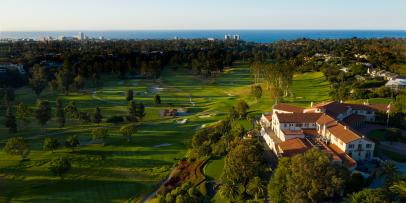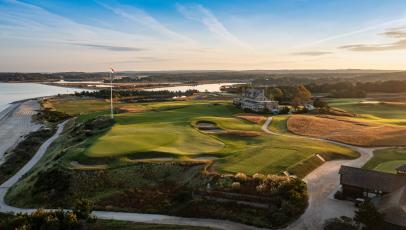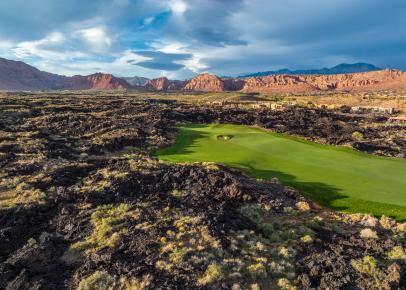Best in State
The best golf courses in California
The argument over which state has the best golf is a fun one—and though we're not here to slam the door on that debate, we think our latest list of the Best Golf Courses in California offers a strong case for the Golden State. For the first time since Golf Digest has started publishing Best in State lists (which dates back to 1977), we have listed 60 courses in California. That speaks to the depth of great golf.
Below you'll find our 2023-'24 ranking of the Best Golf Courses in California. If you're interested in the best public options, check out our collection of the best courses you can play in California.
We urge you to click through to each individual course page for bonus photography, drone footage and reviews from our course panelists. Plus, you can now leave your own ratings on the courses you’ve played … to make your case why your favorite should be ranked higher.

From Golf Digest Architecture Editor emeritus Ron Whitten:
Cypress Point, the sublime Monterey Peninsula work of sandbox sculpture, whittled Cypress and chiseled coastline, has become Exhibit A in the argument that classic architecture has been rendered ineffectual by modern technology.
I'm not buying that argument. Those who think teeny old Cypress Point is defenseless miss the point of Alister MacKenzie’s marvelous design.
MacKenzie relished the idea that Cypress Point would offer all sorts of ways to play every hole. That philosophy still thrives, particularly in the past decade, after the faithful restoration of MacKenzie’s original bunkers by veteran course superintendent Jeff Markow.
Explore our complete review here—including bonus photography and ratings from our expert panelists.










The Dunes Course, long in the shadow of its big brother Shore Course, was originally routed by Seth Raynor, who died before construction. It was completed by Robert Hunter, a partner to Alister MacKenzie (who did not participate in the work), and Raynors ideas for the greens were altered before they were even built. In the 1990s, Rees Jones remodeled the course and reshaped holes to mimic the Raynor look, to mixed reviews. In 2016, Tom Fazio was brought in to make the Dunes as appealing to members as the gorgeous Shore Course, though it was former associates Tim Jackson and David Kahn who conceived of and carried out the details of the plan to give the Dunes a MacKenzie look. Sandscapes now frame most holes, fairways now zigzag around jagged bunkers and nearly all the greens are oriented diagonal to lines of play. The Dunes Course now lives up to its name.

The developers of The Quarry hired Tom Fazio in the early 1990s with instructions that he top his design of Shadow Creek. Fazio was savvy enough to ignore those instructions, because he recognized The Quarry site was a much better piece of topography than what he’d been provided in Las Vegas. Thus The Quarry has more variety, starting and ending in a gravel quarry now lavishly landscaped. In between, holes play on high desert overlooking the Palm Springs Valley and in a valley, with four holes tucked in an isolated notch of the Santa Rosa Mountains. The course regularly receives some of the highest Conditioning scores in the ranking.



When developer Michael Meldman first showed Tom Fazio the land for the proposed Madison Club, an arid, barren desert outside Palm Springs, he told Fazio, “Let’s do a modern-day Shadow Creek.” By “modern-day,” he meant one that would feature homesites along the holes. So Fazio did what he’d done in Las Vegas at Shadow Creek. He had crews dig into the desert and pile up dirt to the sides. But this time, the cuts became channels wide enough for fairways, with pads for home sites perched above holes on surrounding ridgelines. After trucking in and planting mature trees and sodding everything, Fazio was satisfied The Madison Club looked nothing like a typical Palm Springs residential layout. Said Fazio, “If you’re given a free hand in the Coachella Valley, what do you do? You do everything. You move the earth, plant the trees and carve out the streams. You create the entire space. There’s so much here.”



Completing a George C. Thomas hat trick of designs (the others being Los Angeles C.C. (North) and Riviera) is Bel-Air C.C., a charming throwback design that winds through mansion-dotted canyons of Los Angeles, the topography so steep that golfers are guided from hole to hole via a tunnel, an elevator and the city’s most famous suspension bridge, which spans a gulch on the par-3 10th and serves as a dramatic backdrop for the 18th green. Bel-Air’s design had been altered over decades by, among others, Dick Wilson, George Fazio, Robert Trent Jones Jr. and Tom Fazio. But in 2018 Tom Doak erased every bit of their work, removing most of the phony water hazards and faithfully recapturing Thomas’s splashy signature bunkering. To complete a round amidst these Hollywood hills, you’ll definitely encounter a Hollywood star. Her name is Bel-Air.


When Jack Nicklaus completed Sherwood Country Club for industrialist David Murdock in the late 1980s, critics immediately compared it to Shadow Creek, which Nicklaus felt was unfair, since his land—a river valley with homesites on high surrounding hills—was far more natural than the barren Vegas desert. But critics were comparing ledger books. They spent lots of money at Sherwood. Several hundred mature oaks were transplanted at an estimated cost of $6 million. The massive boulders edging some fairways were trucked in as well, and the ponds and streams guarding landing areas and greens were manufactured by experts in that business. In the end, it added up to producing one of the best courses money could buy, until the drought of 2014. Nicklaus returned in 2016 to approve agronomic improvements that reduce water use by 25 percent. Sherwood remains a great layout, but more austere in presentation.

Tradition Golf Club was intended to be Palmer Course Design’s answer to the most opulent private courses in greater Palm Springs, such as The Quarry at La Quinta and Vintage Club (Mountain). Built on the old Hacienda del Gato Ranch, the front nine is routed over rolling desert and through a flood-control basin, while most of the back nine is tucked at the base of the rocky slopes of the Santa Rosa Mountains, with three holes (15th through 17th) curving around a 90-degree bend dubbed the “Coyote Canyon.” Almost every hole here has a distinguishing feature, from desert wash to serpentine waste bunker to double fairway to boulder landscaping to cascading waterfalls. The common overall theme are fields of wildflowers spread throughout the far roughs. During a 2005 Golf Digest Panelist Summit, Arnold Palmer explained he had those flowers planted to appeal to his first wife, Winnie, who loved flora much more than golf.

The Vintage Club proved to be the last collaboration between former tour golfer-turned-architect George Fazio and his young nephew, Tom. But while George was heavily involved in promoting this exclusive Palm Springs area club to prospective members, Tom was sweating the details out on the construction site. The opulent course was built for $6 million, considered an outrageous amount at that time, but Tom explained that sum was necessary in order to “create an environment where none existed,” a phrase he would repeat later in the decade when constructing Shadow Creek in Las Vegas. Tom spent $1.5-million building just The Vintage’s 16th and 17th holes, including three cascading waterfalls at $175,000 apiece. It was money well spent.
 - Jon Cavalier.jpeg.rend.hgtvcom.406.229.suffix/1573163040843.jpeg)


.jpg.rend.hgtvcom.406.229.suffix/1573234111646.jpeg)
.jpg.rend.hgtvcom.406.229.suffix/1573234111646.jpeg)


29. (28) CordeValle Golf Club
San Martin, CA
















.jpg.rend.hgtvcom.406.271.suffix/1660142448226.jpeg)














• • •
Explore Golf Digest's recently relaunched Places to Play community, where you can add star ratings and reviews for all the courses you play. We've collected tens of thousands of reviews from our course-ranking panelists to deliver a premium experience, which includes experts' opinions, bonus course photography and videos, plus much more. Check it out here!



